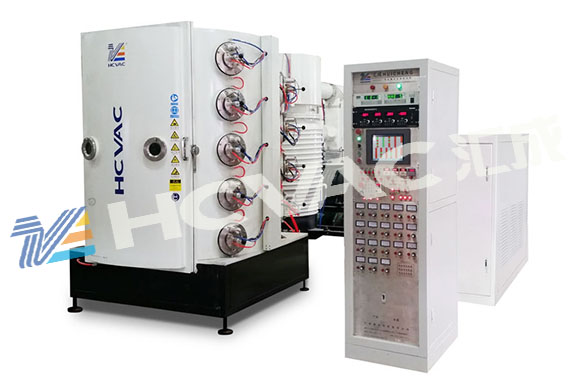pvd coating machine ion nitriding (commonly known as ion nitriding) is a surface chemical heat treatment process that uses the glow discharge generated between the workpiece (cathode) and the anode to perform nitriding in a low vacuum (≤2000Pa) nitrogen-containing atmosphere. In order to reasonably select work tasks, perform process operations correctly, adjust and control appropriately, and even transform and develop ion nitriding equipment, it is necessary to master some basic knowledge of vacuum technology (such as the physical concept of vacuum, vacuum acquisition and measurement methods, etc.) .

Section 1 The concept of vacuum and vacuum degree
In vacuum technology, the gas state with a pressure as low as one atmosphere is collectively referred to as vacuum. This is a thinner state of gas compared to normal atmospheric pressure. The rarefaction degree of the remaining gas in the vacuum is the degree of vacuum, that is, the degree of vacuum.
Section 2 Units of vacuum degree and division of vacuum areas
1. Unit of vacuum degree
According to the definition of vacuum degree, the most direct physical quantity to measure the degree of vacuum should be the number of molecules per unit volume. However, due to historical and technical reasons, the degree of vacuum is expressed by the absolute pressure of the remaining gas in the evacuated air. . "Pressure" refers to the pressure on the container wall per unit area. It is currently an internationally accepted physical quantity indicating the degree of vacuum. The First International Technical Conference in 1958 recommended using "Torr" as a measure of vacuum degree. The unit is defined as "1Torr is 1/760 of 1 atmospheric pressure." Since 1 atmospheric pressure is 760mmHg, Torr can be used interchangeably with mmHg. The unit of pressure specified in the International System of Units (SI) is (Pa), and Pa (Pa) is the specialized name for Newton/meter2 (N/m2). At present, many countries, including my country, have gradually replaced Torr with Pa as the standard basic unit of vacuum pressure.
The higher the vacuum degree, the lower the pressure of the gas, and the fewer the number of gas molecules in the furnace. On the contrary, the higher the gas pressure, the lower the vacuum degree. It can be seen that the pressure is inversely proportional to the degree of vacuum.
In various literature, in addition to Pa and Torr, the units of pressure also include standard atmospheric pressure, bar, and kgf/cm2. The conversion relationship between several commonly used units is shown in (Formula 1-1).
1Torr=133.3Pa
1Pa=75×10-3Torr
1Torr=1mmHg
1Torr=1/760 atmosphere (Formula 1-1)
2. Division of vacuum area
There are many ways to divide the vacuum area. Currently, my country divides the vacuum area into: low vacuum, medium vacuum, high vacuum and ultra-high vacuum. The vacuum values corresponding to each vacuum area are:
Low vacuum: 105~102Pa (760~1Torr)
Medium vacuum: 102~10-1Pa (1~10-3Torr)
High vacuum: 10-1~10-5Pa (10-3~10-7Torr)
Ultra-high vacuum: ≤10-5Pa (≤10-5Torr)
The physical phenomena of molecular motion are different in different vacuum regions. Ion nitriding is carried out in low vacuum, and its pressure range is usually 7~103Pa.
Section 3 Measurement of Vacuum
1. Concept of vacuum measurement
A tool that measures the pressure of a gas below atmospheric pressure is called a vacuum gauge. A vacuum gauge can directly measure the pressure of a gas, or indirectly measure the pressure through physical quantities related to pressure. The former is called an absolute vacuum gauge and the latter is called a relative vacuum gauge.
2. Introduction to commonly used vacuum gauges
There are many types of vacuum gauges. The following is a brief introduction to several vacuum gauges commonly used in domestic ion nitriding equipment.
1. Compression vacuum gauge
Compression vacuum gauge is also called McLeod vacuum gauge, or McLeod vacuum gauge for short. The Mai type vacuum gauge belongs to the category of absolute vacuum gauge. Its advantage is that it has high measurement accuracy and can be used as a standard instrument for vacuum measurement. Its disadvantages are that it is not convenient to use, responds slowly, and cannot measure continuously.
2. Resistance vacuum gauge
The resistance vacuum gauge of the
pvd coating machine is manufactured using the principle that the number of molecules in the vacuum system is related to the heat conduction. The resistance vacuum gauge belongs to the category of relative vacuum gauges.
The advantages of the resistance vacuum gauge are that it has a simple structure, can continuously measure, can measure the total pressure, and is easy to use (wires can be used for long-distance measurement). The disadvantage is that the measurement value of this type of vacuum gauge is related to the type of gas being measured. This is because most of this type of vacuum gauge is calibrated with air when leaving the factory. Due to the presence of hydrogen in the ion nitriding furnace, the thermal conductivity of hydrogen is different from that of nitrogen. The thermal conductivities of air, air, etc. are too different, so the measured vacuum value has a large error. However, because this type of vacuum gauge is practical and convenient, has intuitive readings, and is brave enough to measure the ultimate vacuum degree and pressure rise rate of the furnace body accurately and reliably, it is still the product of choice for most enterprises in our country.
Section 4 Obtaining Vacuum - Vacuum Pump
A vacuum pump is a device that generates, improves and maintains vacuum. According to their different working principles for obtaining vacuum, they can be divided into many types.



